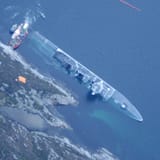>>64160793 (OP)
The Helge Ingstad isn't a completely fair test of the design or the company that made it because the captain made the baffling decision to evacuate even though 129 of the 137 crew were uninjured and the ship was in home waters, right next to shore, and in no immediate danger (it took days to finally sink even with no one onboard). The gash in the hull was long, but very little of it was below the waterline, But the crew left most of the watertight doors open when they abandoned ship and a leak, even a small one, will eventually sink any ship if you do nothing to prevent it.
Now was it a well designed ship? No. The hollow propeller shaft that ran through multiple watertight compartments without adequate sealing was a big flaw, and the fact that the ship lost steering and engine power after taking such minor damage is even less excusable, buuuuuuuuuuuuut we don't know how long it would have taken to restore it or whether the propeller shaft leak would have been fatal if the crew had actually attempted damage control. Blacklisting the company that built the ship over the incident probably isn't justified, and let's face it most of its competitors' designs haven't proven themselves under real life conditions so we don't know if they're any better. For all we know they might have much more serious flaws.
American designs have acquitted themselves quite well, but that's at least in part because the USN is so good at damage control that it compensates for its mixed record for accident avoidance. But American ships are designed to US Navy requirements, not the needs of potential customers on the export market, besides our shipbuilding industry doesn't have the spare capacity to fulfill foreign contracts anyway..
So n practice, other countries have the choice between Navantia which was tested and found wanting (though with extenuating circumstances) or a bunch of firms whose designs haven't been tested at all. You can sorta see why Navantia still makes sales.


